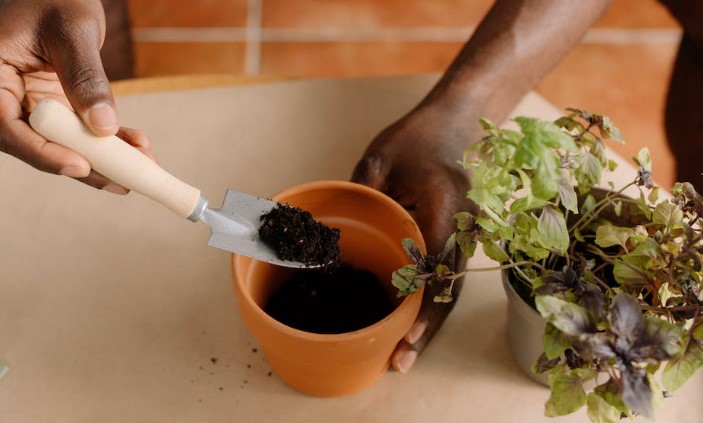How to Care for Indoor Plants (for Healthy and Happy Plants)
If you are starting an indoor garden, understanding how to care for indoor plants is vital to growing a thriving indoor garden. Although caring for houseplants might seem complicated at first, caring for some indoor plants doesn’t need much care.
Caring for indoor plants means providing the right conditions, from regular watering and pruning to fertilization. With proper care, your houseplants will thrive healthy and fill your home with color.
Keep reading and learn everything you need to know about caring for indoor plants.
11 Ways to Care for Houseplants
1. Water Your Plants Regularly
All indoor plants have different watering needs. In general, water your plants only if the topsoil is completely dry. Insert your finger inside the soil; if the soil is damp, the plant doesn’t need watering; however, if the soil is dry, you need to water your plant.
However, avoid overwatering or underwatering your plants at all cost. Overwatering is the most common cause of death in indoor plants. So, you would rather underwater your plant rather than overwater it. Also, ensure your plant pot has proper drainage to drain the excess water.
2. Provide Your Plants With the Right Lighting Conditions

Light is important for all indoor plants because they need sunlight for photosynthesis. However, light requirements vary from one plant to the other. Some thrive in bright, indirect sunlight, while others thrive in low-light conditions.
Avoid putting your plants in direct sunlight, but rather provide them with plenty of indirect light. If the light is not enough, you can use glow lights for plants.
Most flowering plants require at least 12-16 hours of lighting daily, while foliage plants require 14-16 hours daily. Remember to rotate your indoor plants occasionally so that all the parts can receive sunlight.
3. Fertilize Your Plants
Houseplants require fertilizer to thrive well. Most indoor plants grow actively in spring and summer; thus, this is the best time to feed them with fertilizer. However, avoiding over-fertilizing is important, as too much fertilizer will burn your plant roots, leading to stunted growth.
For indoor plants, use a balanced fertilizer(10-10-10) for Nitrogen, phosphorus, and potassium. If you use a fertilizer that is too high in nitrogen, you will have more leaves than flowers.
If you are growing a foliage plant, use a fertilizer high in nitrogen; for flowering plants, use a fertilizer high in potassium. You can also use a fertilizer with micronutrients to prevent plant deficiency.
4. Ensure the Room Humidity is High
Most houseplants, like tropical plants, prefer high humidity, while others, like cacti, don’t really require high humidity.
If your room has low humidity, mist your plant leaves with a room humidifier or place a tray filled with pebbles near the plant. Additionally, you can fill a spray bottle with distilled water and mist your plants for extra moisture.
5. Repot Your Overgrown Houseplants

If your houseplant has overgrown its pot, the roots are circling around the container, and there are drainage issues, these are signs your plant needs repotting. However, note that spring and summer are the best seasons to repot a houseplant.
RELATED: When to Repot Indoor Plants (And Signs to Look for)
6. Prune Your Plant Regularly
The best time to prune your indoor plants is during fall after their active growth in spring and summer. The main reason for pruning is to remove dead or yellow leaves and encourage new growth. We also prune to prevent the plants from growing too big.
While pruning, always make cuts above a leaf node using clean and sharpen pruning shears or scissors. Furthermore, you can also pinch the tips of your plant stems to encourage a bushier growth.
7. Propagate Your Indoor Plants If Needed
Propagating your houseplants when needed is important as it helps rejuvenate overgrown plants plus it encourages new growth.
Some houseplants like spider plants reproduces spiderettes from stems. You can propagate them to increase your spider plant collection.
Additionally, climbing plants like pothos forms new root systems when their stems touch the soil. With pothos, you can form a new plant from cuttings.
8. Watch Out for Bugs

Inspect your houseplants for any signs of bugs like aphids, spider mites, scales, and more. If you notice their presence, treat them immediately. For spider mites and aphids, you can use insecticidal soap.
9. Watch Out for Indoor Plant Diseases
Most of the houseplant diseases are spread by insects, so keeping bugs at bay will help prevent the spread. While others, like root rot, are caused by overwatering.
However, remove the affected plants to prevent spreading to other healthy plants. Some of the houseplant diseases to watch out for include fungal leaf spots and powdery mildew.
10. Clean Your Houseplants

Cleaning your plants to remove dust makes them look better. Most of the dust collects on the leaves, so you can use a damp cloth to wipe away the dust. Cleaning your plants’ leaves regularly helps with better light absorption.
11. Rotate Your Houseplants
Caring for your houseplants also involves rotating them. Rotating your indoor plants ensures they get even sun exposure and also prevents uneven growth development.
Takeaway
Taking care of your indoor plants is a fulfilling experience that will definitely pay off. Healthy and thriving plants will liven up your indoor space.
However, you need to understand your plants’ specific needs to provide them with proper care, like water and light, which will contribute to their overall health.
RELATED: 13 Best Indoor Plants for Every Room
How Often Should You Water Indoor Plants?
All indoor plants have different water needs. Some, like tropical plants, require consistent watering, while others, like succulents, don’t need much watering.
Generally, most houseplants need watering twice a week during the spring and summer but less watering in winter, depending on the type of plant.
How Do I Make My Indoor Plants Happy?
To keep your houseplants happy, ensure they get regular watering while avoiding overwatering, get enough sunlight, and protect them from insects. This way, your plant will grow healthy and happy.
Do Indoor Plants Still Need Sun?
Yes, all indoor plants need sunlight. While they don’t need direct sunlight, most thrive in bright, indirect sunlight and low-light conditions.
So, place them where they will receive enough sun exposure, which is essential for photosynthesis. If natural light is not enough, you can use artificial lights designed for plants.
Author Profile

- 🌿 Hello! I'm Mary, the nature-loving soul behind Serene Eden. Gardener, plant whisperer, compost connoisseur, sun-soaked plant enthusiast, and avid bee-watcher. Let's cultivate beauty, one bloom at a time. 🌱🌼
Latest entries
 Sustainable gardeningSeptember 2, 2024What is Sustainable Gardening?
Sustainable gardeningSeptember 2, 2024What is Sustainable Gardening? CypressAugust 7, 2024Leyland Cypress Tree – How to Grow and Care for leyland Cypress
CypressAugust 7, 2024Leyland Cypress Tree – How to Grow and Care for leyland Cypress Vegetable GardeningJuly 4, 2024Determinate Vs. Indeterminate Tomatoes
Vegetable GardeningJuly 4, 2024Determinate Vs. Indeterminate Tomatoes Vegetable GardeningJuly 3, 2024Growing Tomatoes in Pots – 9 Expert Tips for a Big Harvest
Vegetable GardeningJuly 3, 2024Growing Tomatoes in Pots – 9 Expert Tips for a Big Harvest



